Definition and purpose
Overview of their role in clinical practice
Improved Efficiency and Accuracy
How 3-part hematology analyzers streamline the testing process
Enhanced accuracy in cell counting and differentiation
Cost-Effectiveness
Comparison of costs between 3-part analyzers and alternative methods
Long-term savings for healthcare facilities
Comprehensive Blood Analysis
Detailed information provided by 3-part analyzers
Parameters measured and their clinical significance
Rapid Turnaround Time
Quick results for timely diagnosis and treatment decisions
Impact on patient care and outcomes
User-Friendly Interface and Automation
Ease of use for laboratory technicians
Automation features that improve workflow efficiency
Integration with Laboratory Information Systems (LIS)
Seamless data management and integration with electronic health records
Benefits of centralized data storage and accessibility
Quality Control and Maintenance
Importance of regular maintenance and calibration
Quality control measures to ensure accurate results
Future Developments and Advancements
Emerging technologies in 3-part hematology analyzers
Potential impact on clinical practice
Conclusion
Case Studies and Real-World Applications
Showcase examples of how 3-part hematology analyzers have been utilized in actual clinical scenarios
Highlight the positive impact on patient care and diagnostic accuracy
Comparison with Other Hematology Analyzers
Briefly discuss the differences between 3-part analyzers and other types, such as 5-part analyzers
Explain the specific advantages of 3-part analyzers in certain clinical settings
Training and Support
Importance of proper training for laboratory staff using 3-part analyzers
Availability of technical support and resources from manufacturers
Regulatory Considerations
Overview of relevant regulatory guidelines and standards for implementing 3-part hematology analyzers
Compliance requirements for quality assurance and patient safety
Limitations and Challenges
Address any limitations or challenges associated with 3-part analyzers in clinical practice
Discuss strategies for mitigating these challenges and maximizing the benefits
Future Directions and Research Opportunities
Potential areas for further research and improvement in 3-part hematology analyzer technology
Collaboration opportunities between manufacturers, researchers, and healthcare providers
Conclusion
Recap the key benefits of 3-part hematology analyzers in clinical practice
Emphasize the importance of adopting this technology for enhanced patient care and diagnostic accuracy
As technology advances, the medical field continues to make significant strides in improving patient care. One of the most important aspects of healthcare is accurate diagnosis, and hematology analyzers play a vital role in achieving this goal.
Hematology analyzers are machines that analyze blood samples to determine various parameters, including the number of red blood cells, white blood cells, and platelets present in the sample. The traditional 2-part hematology analyzers have been used for many years, but with the advent of 3-part hematology analyzers, healthcare providers can now access more comprehensive and accurate results.
In this blog post, we will explore the benefits of using 3-part hematology analyzers in clinical practice.
1. Improved Accuracy
One of the primary advantages of 3-part hematology analyzers is their ability to provide more accurate results. These machines use advanced technology to differentiate between different types of white blood cells, which is essential for accurate diagnosis and treatment.
In traditional 2-part hematology analyzers, white blood cells are classified into two categories: lymphocytes and non-lymphocytes. However, 3-part hematology analyzers can differentiate between three types of white blood cells: lymphocytes, monocytes, and granulocytes. This added level of accuracy can be particularly useful in diagnosing conditions such as leukemia, where accurate identification of different types of white blood cells is crucial.
2. Increased Efficiency
Another significant benefit of 3-part hematology analyzers is their increased efficiency. These machines can analyze blood samples much faster than traditional 2-part analyzers, saving time for both healthcare providers and patients.
Additionally, 3-part hematology analyzers require less manual intervention than their predecessors. The machines are designed to automatically flag abnormal results, reducing the need for manual review and ensuring that only accurate results are reported.
3. Enhanced Patient Care
The improved accuracy and efficiency of 3-part hematology analyzers ultimately lead to better patient care. With more accurate results, healthcare providers can make more informed diagnoses and treatment decisions, resulting in better outcomes for patients.
Furthermore, the increased efficiency of these machines means that patients can receive their results faster, allowing for more timely treatment and reducing patient anxiety.
4. Cost-Effective
While 3-part hematology analyzers are more expensive than traditional 2-part analyzers, they can be cost-effective in the long run. The increased accuracy and efficiency of these machines can lead to fewer repeat tests and reduced costs associated with manual intervention.
Additionally, the improved patient outcomes resulting from more accurate diagnoses and timely treatment can lead to reduced healthcare costs in the long run.
Conclusion
In conclusion, 3-part hematology analyzers offer several benefits over traditional 2-part analyzers in clinical practice. These machines provide more accurate results, increased efficiency, enhanced patient care, and can be cost-effective in the long run.
As technology continues to advance, it is essential for healthcare providers to stay up-to-date with the latest developments in their field. By investing in
3-part hematology analyzers, healthcare providers can provide better care for their patients while also improving their bottom line.




